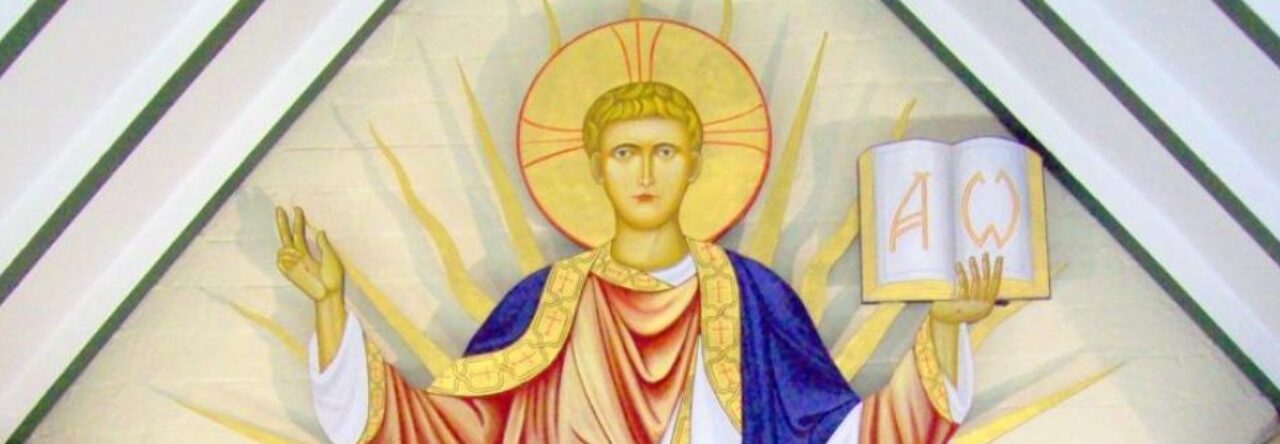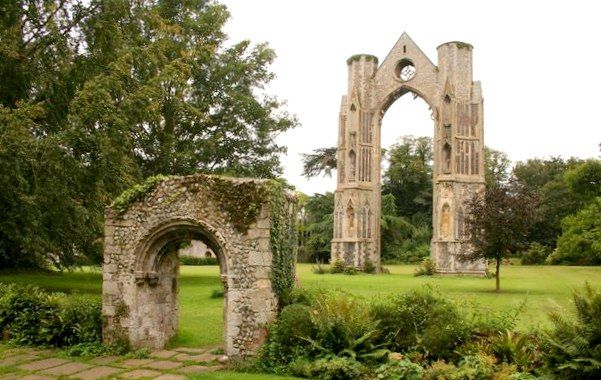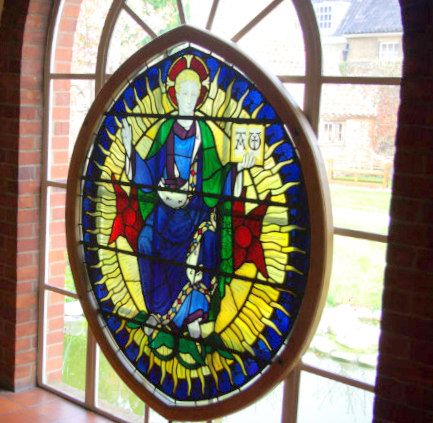Dear friends,
Holy Week and Easter are fast approaching. (The notion that time can expand or contract is not I can remember the football results on Saturday TV taking an age while Doctor Who flashed by in seconds!) Once again we gather in the park to commemorate Our Lord’s entry into Jerusalem on Palm Sunday. Once again we gather in the Upper Room with Jesus and the disciples as we re-enact the events of that aweful night. Once again, we have our feet washed and Watch with the Lord in the Garden of Gethsemane. Once again we gather at the close of Good Friday to hear the Gospel of the Passion and Crucifixion of the Lord and to kneel at the Foot of the Cross. Once again, we wait in vigil for the Risen Christ on Holy Saturday evening – and rejoice in His glorious Resurrection in the darkness of that first Easter. (None of the sunrise nonsense. Mary Magdalene came to the tomb “while it was yet dark” and found the tomb empty.) Easter is the start of FIFTY DAYS of celebrations and must be celebrated as such. I won’t use the “A” word yet, it still being Lent when I write this. If you don’t know what the “A” word is then ask me – or come to church and find out. Pray for fellow Christians throughout the world as they keep, with us, these celebrations.
At this stage in Lent I would like to say how well-supported the prayer-times before mass have been, I was determined not to allow parish busyness to take over from prayer and adoration of the Lord in his Holy Sacrament. Having people to join in Morning and Evening Prayer at various times has also been an encouragement. Jesus made very clear that “Where two or three are gathered in my Name, there I am in the midst of them.” Speaking to Joe Smith (an aspiring priest-to-be from S. Paul’s, Burslem) about his week spent in our parish and church, I asked him what had been most significant. The Sunday Mass apart (Joe is from an evangelical background so the experience of worship here was new ground!), Joe spoke about the daily round of worship and the fact that the church building is open and used each day. As Joe will learn, clergy spend a lot of time operating a solitary ministry, even if it is among many people. Having a community of praying people, people who believe it is important to pray together and support the worship of the church, is a huge encouragement to any priest. Sadly, the absence of fellow worshippers can be an equally huge discouragement. In most of my time at Sneyd Church there has been much encouragement – and not least during the days of Holy Week. The great Triduum (the three days of Maundy Thursday, Good Friday, and Holy Saturday) are a source of joy as we share in the Lord’s deep sorrow and come to the glory of the Resurrection.
While on the subject of sorrow, I can’t conclude without a comment about the non-appointment of the Bishop of Sheffield. Father Philip North, a traditionalist bishop from Blackburn Diocese was appointed to be Bishop of Sheffield. As the news spread, so an evil campaign against his appointment was started via Twitter and Facebook (Whatever they are!) by those in the Church of England who do not wish to abide by the General Synod’s declaration that all members of the CofE, regardless of their theological position over women priests and bishops, are full and valued members of that church. The highly personal attack on Father North (who is an excellent person, priest, and bishop) was conducted by those who would like to see all opposition to womens’ ordination crushed. I am sorry that Father North didn’t stick to his guns – but I am not he. As someone observed, “The very qualities that make him a good bishop are the qualities that would make him feel unable to minister in the face of opposition.” What this says about mob rule in the Church of England remains to be seen. It was a pity that the two archbishops didn’t speak out immediately and strongly once the campaign began. Keep Father Philip and his persecutors in your prayers.
ON an in-house note, lovely to see Mavis Hollinshead back with us in church. She is staying with her daughter and family in Canada and is back for three months to worship both here and at PVFC, not to mention stocking up with oatcakes. Flew in Tuesday afternoon — at mass on the Wednesday evening. Praise the Lord!
Every blessing for the rest of Lent, Holy Week, and Easter.
WHO DO YOU THINK YOU ARE?
The title of a TV programme where various well-known people are invited to search out their family tree. It can be a bit revealing as delving into the past reveals family “black sheep” which can be embarrassing to those who are well-known and “pillars” of society. Tracing back in the family’s line can reveal thieves, cheats, jail-birds and murderers etc.
Grand delusions. There is usually someone in the family who reckons kinship with titled landowners, admirals, royal favourites, famous Artists and Composers and so on. There is one extraordinary exception as a result of the discovery of the 600 year old grave of King Richard III who was killed at the Battle of Bosworth Field. His skeleton was subjected to various DNA tests and the result was that the bloodline lay with a craftsman who constructed the coffin to take the royal remains for final burial in Leicester Cathedral. The undoubted royal link with the King has not made any difference to his way of life. What is a historic fact is that the Secretary of Queen Elizabeth I was a man called Davison. The Queen, well-known for her dillying and dallying would not sign the death warrant of Mary, Queen of Scots. It was an act of regicide which repelled her. Davison managed to slip the death warrant in between a sheaf of papers waiting for the royal signature. When the Queen found out that her Secretary was responsible for slipping the death warrant into a pile, she was furious, fined the luckless secretary £100 and sent him to the Tower of London. Nothing further is recorded and the modern Davison family has to content with a line of farmers and green grocers!
What’s in a name? It is obviously important to teach children, when they begin to talk, to identify objects around them e.g. cup, plate, jug, spoon, along with its surroundings e.g. door, window, table, dog, cat … to say nothing of Mummy and Daddy. Remember Cash printed labels to sew in to school kit? Vital when it comes to claim them as yours? Families likewise are recognised by a name. How this came about is hidden in the mists of time. Certainly the Roman aristocracy had family names. How far that extended into the peasant world would be impossible to evaluate. What is a fact is that in medieval times when few travelled beyond their immediate surroundings, they would have a Christian name given at Baptism. That would be followed by the name of the village or town where they lived.
An interesting example of a family name is Henry Chichele Archbishop of Canterbury and Chancellor of England in the time of Henry V. It has been traced that this family came from the Bedfordshire village of Chichele, moving at some time to Higham Ferrers in Northamptonshire where the boy Henry would go to school. So in the first place, the family would simply be name “of Chichele”. By the time they were settled in the town the “of” was dropped and Chichele became the surname.
Steps foward. Linking a family with their trade would help to recognise individuals. This has come down to present day as we have scores of surnames linking with the original family trade. So there is Carpenter, Taylor, Colman, Butler, Shearer, Butcher, Baker, Fisher, Weaver, Mercer, Clark, Gold, Booker, Dyer, Boot, Church, Beer, Carter, Wood… and so on. A complete list of names originating in worthy trades, skills, could fit several pages. Some, outside that category could be embarrassing … Death becomes De’Arth and Sidebottom is adjusted to (phonetically) siddibothoame. A Cotswold hamlet in the 1930’s had the Gotobeds!
The New World. The 17th century Pilgrim Fathers settled in North America; English Puritans, they were prepared to emigrate to avoid persecution at home. At first the going must have been horrid and unrewarding. Disease took its toll, but in the end they prospered and spread. Present-day Boston took pride in its roots and there grew up a Boston elite, proud of their origin in the English founders.
Immigration, immigration, immigration. The human flood from perhaps every European country, must have left the native American Indians bewildered as the human tide flowed over their land with its sacred places. One record of interest is that a sailor from Gravesend in Kent, brought home an Indian bride named Pochahontas. It must have been a nine-day wonder in Gravesend. How did she get accustomed to an English house after her life in a skin-covered wigwam? Her grave is in a churchyard in Gravesend.
Name strain. By the mid 19th century North America would be rapidly settled by European (mostly) immigrants some with outlandish family names. Some countries had a language which seemed to have a reluctance to use vowels a,e,i,o,u. This produced family names which were simply unpronounceable to their neighbours of a different race. In the end families changed or simplified their name – so that a name, for example, ending Czhrort! Some immigrant families quickly rose to fame, wealth and power and had no need to “adapt” their names, such as Vanderbilt, Roosevelt, Guggenheim.
DRUMP-H, One Heinrich D left his native Germany sometime in the late 19th century. Settling down to do well, he made a fortune. Going up in the world the family name was “gentrified” into TRUMP. Donald T has now risen to be President of the U.S.A. as well as a considerable property owner and a billionaire, his tall German stock with fair hair atop, typically solidly built. If / when he makes a Russian trip, Vladimir PUTIN will be dwarfed when side by side.
Trump has several meanings in English, as follows:
Turning up “Trumps” means an unsuspected success.
“Trumped up” charge, in law means false, made-up accusations.
“Trump” Cards, an advantage in card games when breaking into the suit in hand.
“Trump,” a “fine fellow” as used in Dickens’ Pickwick Papers.
“Trumpery,” rubbish, as used in the trial of Joan of Arc way back in the 14th century when the Bishop of Beauvais so dismissed her visions/voices when presiding at her trial.
“Trump” (slang) The loud and uncontrolled noise when stomach wind forces its way out of the body. Never, of course to apply to Royals, who do not cough, sneeze, blow the nose, in public.
Summing up – With all the meanings of Trump, some good, some crafty but, it would be fair to give the new President a chance. If, and when he first meets the Queen, it could be both historical and hysterical.
Who do you think they are? A recent “shock” to some was a newspaper heading “Church of England’s remorse for the Reformation’s lasting damage.” This was the heading for a joint statement by the Archbishop of Canterbury and York. An important admission at the time of the 500th anniversary of the revolt triggered off by Martin Luther’s nailing to the door of Wittenberg Castle a list of the corruption in the Church of Rome. Luther, a monk, could no longer bear to conceal some very tricky developments both in the faith, morals and corruption in the Vatican and widely spread, including paying cash down to release souls from Purgatory.
Fatal failure. Attempts to call a council of catholic and Lutheran theologians came to nothing, probably because Rome had perhaps a guilty conscience with no wish to wash “dirty linen” in public. The inevitable split divided Europe’s Christians. Lutheran followers were divided among the various German Principalities whose rulers were sympathetic, a matter of “cuius religio, eius religio, in other words “follow the ruler.” Soon bloodshed and riots smothered the Lutheran movement. In one German town there was a sudden outbreak of claims to be spirit-filled. Riots and bloodshed resulted, and military intervention brought about wholesale massacre of the citizens.
Henry v Luther. There seems to exist, deeply rooted in the nation’s racial memory, that on a certain date in the reign of Henry VIII England went to bed Catholic and woke up “Protestant.” The truth is that Henry was no protester and had such a hatred of Luther that he wrote a book in defence of the Church’s faith, which delighted the Pope and awarded the King with the title Defender of the Faith.
After Henry’s head-on collision with the Pope who would not permit a divorce from Queen Catherine, it is clear that the decision to break with Rome was political and not doctrines like Luther’s. From now on Henry’s inflated self-importance would make him supreme over everything. He demands that all the bishops should sign a document of acceptance. Such was the reign of terror, all bishops, except one, the Bishop of Rochester, gave in and the saintly Bishop John Fisher was beheaded. Meanwhile the Church with its traditional apostolic ministry carried on, with some English permitted and an English Bible in 1538. Luther’s break-away became the Lutheran Church and lost the traditional ordained ministry. Here we had no “Henrician” break-away, but the Church in England continuing.
Too late. The tragedy is that in 1563 the RC Council of Trent declared “the utter extinction of abuses of holy observances and practices and that all superstition involving the saints be put away.” Nowadays R.C biblical studies abound and the Bible is held in esteem. The tragedy is that Christians become more and more divided with violence, bloodshed and drawn out war persisted.
Who do they think they are? The Archbishops of Canterbury and York have rightly risen above all the bigotry, ignorance, narrow-mindedness, even downright hostility, which the Reformation caused, even to this day. A high price to pay for a well-meant search for truth and to Worship God in the beauty of holiness.
Fr. Roger


